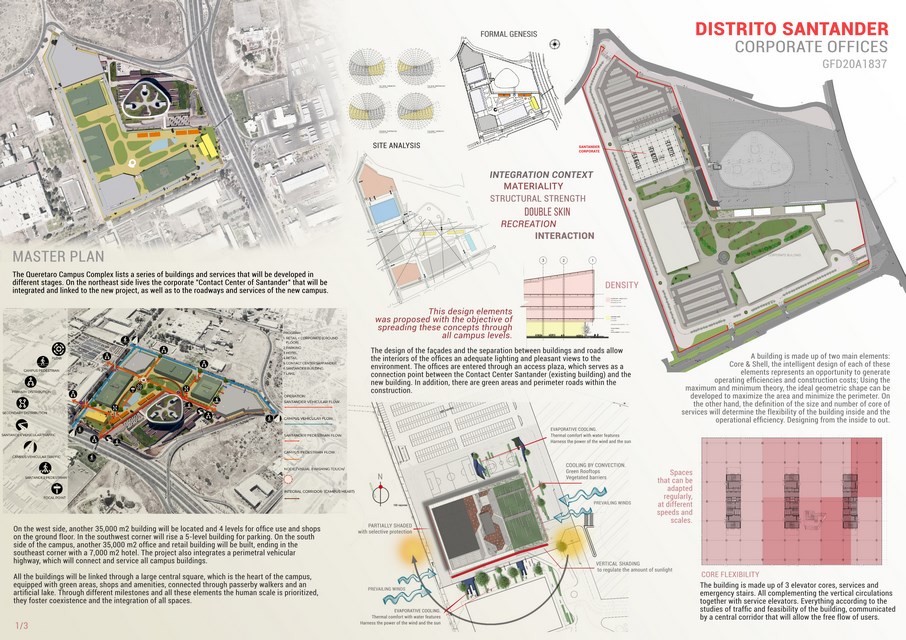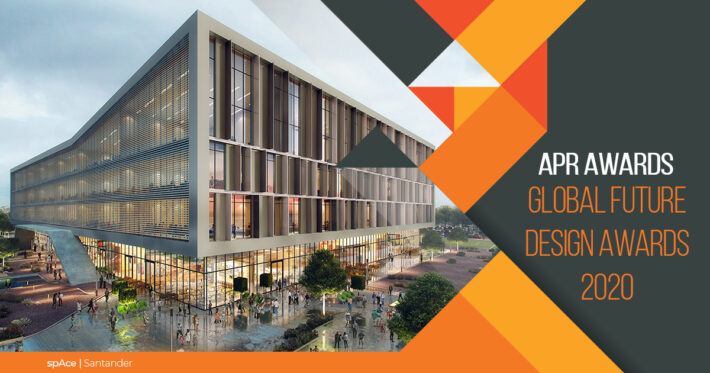The project DISTRITO SANTANDER is located in the city of Querétaro, México. Located on Av. 5 de Febrero, in the Benito Juárez Industrial Zone and very close to the Jurica area. The Querétaro Campus Complex lists a series of buildings and services that will be developed in different stages. On the northeast side lives the corporate “Contact Center of Santander” that will be integrated and linked to the new project, as well as to the roadways and services of the new campus.
Winner- Global Future Design Awards 2020
Firm | spAce
Architect/Designer | Juan Carlos Baumgartner
Category | Office Building Concept
Team | Juan Carlos Baumgartner / Alejandro Danel
Country |Mexico
Photographer/Copyright | ©Courtesy of spAce

ARCHITECTURAL PROJECT: Juan Carlos Baumgartner, Alejandro Danel, Shantal Bravo
COLLABORATORS: Rafael Briones, Elisur Mogollón, Mauricio Juárez, Rene Estrada, Oscar Rodriguez, Maria Teresa Darela, María Fernanda Araiza, Arturo Arenas
LIGHTING: LUA
PROJECT DATE: 2020…
LOCATION: Conjunto Campus Querétaro. Av. 5 de febrero, in the Benito Juárez Industrial Zone. Querétaro, México
BUILDER: PARKS
AREA: 31,000 sqm
The first stage of the campus incorporates Distrito Santander located in the north zone, a building of 4-level offices and approximately 31,000 m2 and an annex parking lot with capacity for 2,100 parking spaces distributed over 4 levels on the sidewalk level. This area will be linked to the existing building of Santander but will also remain independent from the rest of the set.
On the west side, another 35,000 m2 building will be located and 4 levels for office use and shops on the ground floor. In the southwest corner will rise a 5-level building for parking. On the south side of the campus, another 35,000 m2 office and retail building will be built, ending in the southeast corner with a 7,000 m2 hotel. The project also integrates a perimetral vehicular highway, which will connect and service all campus buildings.
All the buildings will be linked through a large central square, which is the heart of the campus, equipped with green areas, shops and amenities, connected through passerby walkers and an artificial lake. Through different milestones and all these elements the human scale is prioritized, they foster coexistence and the integration of all spaces.
The Project DISTRITO SANTANDER, is a building that will house offices in most of its spaces. The extent consists of a lower body (base) of the main body and an upper body, this with an inclination at one end. Most of the façades are of curtain wall with efficient Low E type glass and solid elements in their corners that frame each of the façades. The building will have solar control elements, such as louvers on the south façade and vertical sunshades as well as aluminium panels on the east and west façades.
The ground floor, like the upper levels, will be destined to office space, with the particularity of having a higher height against the rest of the mezzanines, additionally this is patched from the rest of the levels, generating a perimeter cover.
Although the ground floor has different accesses in its 4 façades, these will be restricted and of highly-controlled use for services, maintenance and/or emergency. The building is accessed from the South façade, making it the main one. The floors and basement become key elements to emphasize access and delimit the areas of the square, walkers and landscaped spaces. The building will be surrounded by green spaces with spaces for hang-outs to take advantage of the local climate and give life to the square.
The design of the façades and the separation between buildings and roads allow the interiors of the offices an adequate lighting and pleasant views to the environment. The offices are entered through an access plaza, which serves as a connection point between the Contact Center Santander (existing building) and the new building. In addition, there are green areas and perimeter roads within the construction.
The building is made up of 3 elevator cores, services and emergency stairs. All complementing the vertical circulations together with service elevators. Everything according to the studies of traffic and feasibility of the building, communicated by a central corridor that will allow the free flow of users.
The access floor is located on the sidewalk level, consisting of a free floor for the use of offices. The reception and the main access will be located on the south façade. There are 3 cores of elevators and services, emergency stairs, toilets and electrical rooms. This floor has a higher mezzanine height and is the base of the project.
Levels 1 and 3 (destined for office use) consist of a free floor with 3 elevator cores and services. With the particularity of solar control elements on the upper levels: horizontal louvers on the south façade and vertical parasols on the east and west façades. In addition, a step will be left on the slab in preparation for internal-use stairs of the offices that will communicate to the different levels.
Similar to levels 1 and 3, level 2 also has 3 elevator cores and services with solar control elements on façades (louvers and parasols). The vertical parasols will have a different distribution to break the monotonous line on east/west façades and to generate different movement and textures on these two façades.
On the roof level the services that feed the building are located: electrical equipment: substation receiving, electrical substations, electrical rooms, generating plants and air conditioning equipment (chillers and pumping equipment). This whole system is connected above the lid slab to the cores of the different levels. As an architectural detail, the roof slab has a slope on its east side, which gives dynamism to the overall extent.
Additionally the building was designed with the use of rapidly renewable materials, all interiors are solved with low VOC materials, and with high recycled content.





